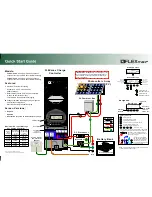
Functional overview
STM32L151xC/C-A STM32L152xC/C-A
26/133
DocID026119 Rev 5
3.11
DAC (digital-to-analog converter)
The two 12-bit buffered DAC channels can be used to convert two digital signals into two
analog voltage signal outputs. The chosen design structure is composed of integrated
resistor strings and an amplifier in non-inverting configuration.
This dual digital Interface supports the following features:
•
Two DAC converters: one for each output channel
•
8-bit or 12-bit monotonic output
•
Left or right data alignment in 12-bit mode
•
Synchronized update capability
•
Noise-wave generation
•
Triangular-wave generation
•
Dual DAC channels, independent or simultaneous conversions
•
DMA capability for each channel (including the underrun interrupt)
•
External triggers for conversion
•
Input reference voltage V
REF+
Eight DAC trigger inputs are used in the STM32L151xC/C-A and STM32L152xC/C-A
devices. The DAC channels are triggered through the timer update outputs that are also
connected to different DMA channels.
3.12 Operational
amplifier
The STM32L151xC/C-A and STM32L152xC/C-A devices embed two operational amplifiers
with external or internal follower routing capability (or even amplifier and filter capability with
external components). When one operational amplifier is selected, one external ADC
channel is used to enable output measurement.
The operational amplifiers feature:
•
Low input bias current
•
Low offset voltage
•
Low-power mode
•
Rail-to-rail input
3.13
Ultra-low-power comparators and reference voltage
The STM32L151xC/C-A and STM32L152xC/C-A devices embed two comparators sharing
the same current bias and reference voltage. The reference voltage can be internal or
external (coming from an I/O).
•
One comparator with fixed threshold
•
One comparator with rail-to-rail inputs, fast or slow mode. The threshold can be one of
the following:
–
DAC output
–
External I/O
–
Internal reference voltage (V
REFINT
) or a sub-multiple (1/4, 1/2, 3/4)
















































